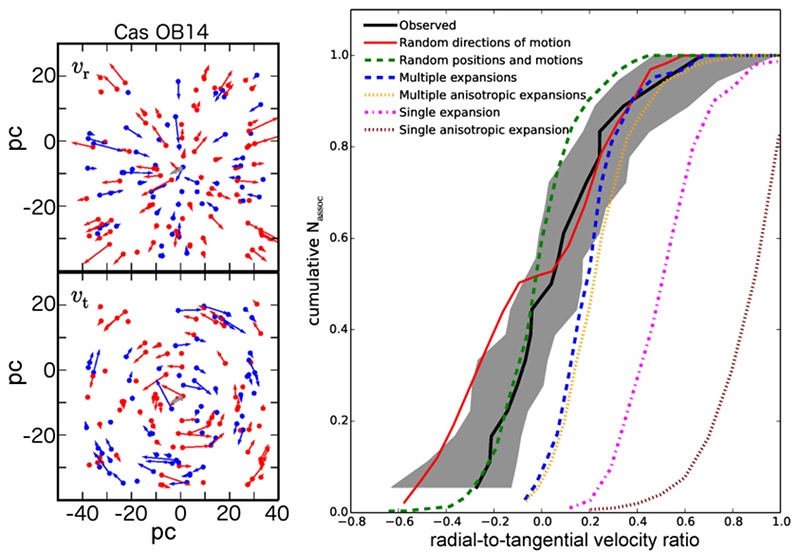
|
EPoS |
|
EPoS Contribution
|
|
Not all Stars Form in Clusters - Measuring the Kinematics of OB Associations with Gaia
Jacob Ward U Heidelberg, Heidelberg, DE | |
| It is often stated that star clusters are the fundamental units of star formation and that most, if not all, (massive) stars form in dense stellar clusters. In this monolithic formation scenario, low density OB associations are formed from the expansion of gravitationally bound star clusters following gas expulsion due to stellar feedback. From N-body simulations, one would expect associations that formed in this manner to continue to exhibit positive radial velocities and elevated levels of anisotropy over 10s of Myr. However, recent theoretical and observational studies suggest that star formation is a hierarchical process, following the fractal nature of natal molecular clouds and allowing the formation of large-scale associations in-situ. Using the Tycho-Gaia Astrometric Solution (TGAS) catalogue, we quantify four key kinematic diagnostics for 18 nearby OB associations in order to determine whether the typical kinematic behaviour of OB associations is consistent with a monolithic star formation scenario. We compare the distributions of each of these diagnostics with those derived from model OB associations with kinematics representative of random motions and expansion, both from a single cluster and from multiple clusters. None of these diagnostics show any evidence of expansion, and the observed kinematics are best represented by a random velocity distribution. This result favours the hierarchical star formation model in which a minority of stars forms in bound clusters and large-scale, hierarchically-structured associations are formed in-situ. I will discuss the implications of these results with particular emphasis on the unique potential of Gaia to distinguish between the monolithic and hierarchical (massive) star formation paradigms, as well as discussing the limitations of the existing data. Finally, I will discuss the potential for combining future Gaia data releases with data from radial velocity surveys to perform a 6-dimensional analysis of the nature and origin of OB associations in our Galaxy, and the numerous challenges faced by such a project. | |
 | |
| Caption: Left: The radial (upper panel) and tangential (lower panel) velocity components of the OB association Cas OB14 in the plane of the sky, determined using positions, parallaxes, and proper motions from the TGAS catalogue. Right: The normalised cumulative distribution of radial-to-tangential velocity ratios measured for the observed OB associations (solid black line). Also shown are the normalised distributions for six sets of model OB associations. The solid red line marks the distribution of those model associations with stellar positions fixed to those observed in nearby OB association but with randomised directions of motions for all stars. The dashed green line represents the distribution for models in which all positions and velocities are randomly generated. The blue dashed and the orange dotted distributions represent model OB associations which are expanding from many points both with and without elevated levels of anisotropy. The final two distributions represent model OB associations which are expanding from a single point (magenta dash-dot) and model associations expanding anisotropically from a single point (maroon dotted). The observed distribution is best represented by a combination of the two model cases with randomised velocity fields. | |
| Collaborators: D. Kruijssen, U Heidelberg, DE |
Key publication
Suggested Session: High-mass star/star cluster formation |